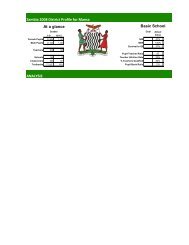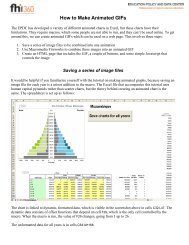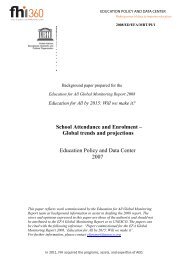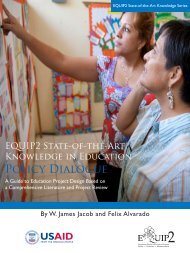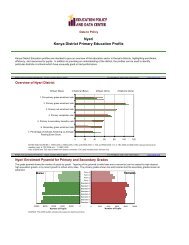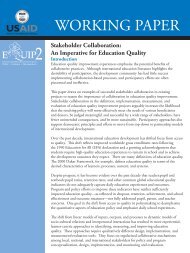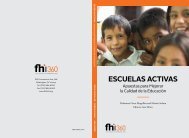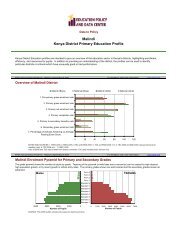EQUIP2 Final Report.pdf - Education Policy Data Center
EQUIP2 Final Report.pdf - Education Policy Data Center
EQUIP2 Final Report.pdf - Education Policy Data Center
Create successful ePaper yourself
Turn your PDF publications into a flip-book with our unique Google optimized e-Paper software.
do this for $1 million, but here’s what we can do,” and that allowed us<br />
to negotiate a more responsible project. The design team would create the<br />
proposal on the ground in cooperation with the government, the mission,<br />
and other stakeholders. In the competitive process, there’s only so much<br />
information you can garner. With EQUIP, we could involve the main<br />
players.<br />
35<br />
Conclusions<br />
Allowing for interactive, participatory, and detailed planning among<br />
the ministry, the implementer, and USAID reduces uncertainty and<br />
misunderstandings. It is a key strategy for ensuring that the people involved<br />
have direct ownership of the project.<br />
Additionally, as previously mentioned, EQUIP occurred during a period<br />
when education programming was growing quickly in USAID missions<br />
around the world, and the ease of the EQUIP mechanism made it possible<br />
for such programming to expand quite rapidly over a period of nine<br />
years. The same expansion might not have been possible if full and open<br />
competition was used for each mission. Another benefit to the mechanism<br />
was the link between the research of the Leader award and the technical<br />
aspects of the associate awards, even though this link was not as strong as<br />
it might have been. In summary, the pre-competed aspect of the award<br />
provided tangible benefits to USAID missions and bureaus as a flexible,<br />
responsive, participatory, and rapid mechanism.<br />
When designing mechanisms that have a Leader and associate<br />
award component, it is useful to have a formal link between them to<br />
ensure effective knowledge translation from research to projects.<br />
When it was first designed, the EQUIP mechanism incorporated a specific<br />
lesson learned from previous indefinite quantity contracts (IQCs): missions,<br />
not the Leader award, should have direct control over projects in order to<br />
ensure ownership and to reflect mission and country priorities. However,<br />
the EQUIPs were criticized for the lack of a formal connection between the<br />
Leader and associate awards, particularly in terms of research. There were<br />
several reasons for this lack of connection.<br />
First, no one anticipated the tremendous demand for associate awards, or the<br />
range of interventions these demands would represent. When the research<br />
agenda was originally set, the education policy expert team had to make<br />
informed judgments about the key issues facing education development<br />
without the associates awards as they were not yet available. For example, in<br />
2003, two of the anticipated research areas were emergency education and<br />
HIV/AIDS, both of which were urgent topics at the time. However, neither<br />
theme was determined to be important in the associate awards. Second,




